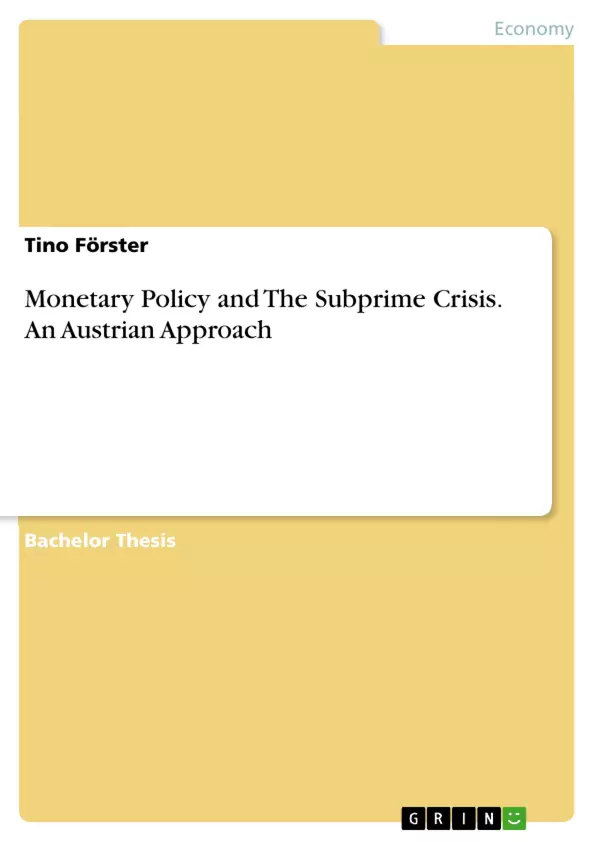Blick ins Buch

Monetary Policy and The Subprime Crisis. An Austrian Approach
Bachelorarbeit, 2014
34 Seiten, Note: 1,0
Leseprobe
Inhaltsverzeichnis (Table of Contents)
- Introduction
- The Austrian Theory of the Business Cycle
- Capital-based macroeconomics
- The market for loanable funds
- The production possibilities frontier (PPF)
- Stages of production
- Capital-based macroeconomics model
- The Business Cycle
- Monetary expansion, the market for loanable funds and the PPF
- Artificial interest-rates and the structure of production
- Boom and Bust
- The Subprime Crisis and the Austrian Theory
- Monetary policy and regulation before and during the crisis
- Application of the theory
- Evaluation of the Subprime crisis
- Conclusion
Zielsetzung und Themenschwerpunkte (Objectives and Key Themes)
This paper aims to demonstrate the relationship between monetary policy and the occurrence of economic crises, focusing on the Subprime Crisis in the United States. It examines the Austrian theory of the business cycle and its underlying model, capital-based macroeconomics, to analyze the impact of artificially low interest rates on resource allocation and economic fluctuations. The paper then applies this theory to the Subprime Crisis, exploring the role of the Federal Reserve System in the development of the crisis. Key themes of the paper include:- The Austrian theory of the business cycle
- Capital-based macroeconomics
- The impact of monetary policy on economic cycles
- The role of the Federal Reserve System in the Subprime Crisis
- The consequences of unbalanced changes in the structure of production
Zusammenfassung der Kapitel (Chapter Summaries)
The paper begins with an introduction that outlines the controversy surrounding the role of central banks and monetary policy in modern economies. Chapter 1 delves into the Austrian theory of the business cycle, explaining how artificially low interest rates can lead to misallocations of resources and economic fluctuations. This chapter examines the capital-based macroeconomics model, exploring the relationship between the market for loanable funds, the production possibilities frontier, and stages of production. Chapter 2 focuses on the application of the Austrian theory to the Subprime Crisis. It investigates the monetary policy and regulations employed before and during the crisis, analyzing the actions of the Federal Reserve System. The chapter also examines the impact of these policies on the American structure of production. Finally, the paper concludes by arguing that expansionary monetary policy and flawed government regulations were the primary causes for the unbalanced changes in the structure of production and the ensuing recession.Schlüsselwörter (Keywords)
The primary keywords and focus topics of this paper include the Austrian theory of the business cycle, capital-based macroeconomics, monetary policy, the Subprime Crisis, the Federal Reserve System, economic fluctuations, resource allocation, and the structure of production.
Ende der Leseprobe aus 34 Seiten
- nach oben
Details
- Titel
- Monetary Policy and The Subprime Crisis. An Austrian Approach
- Hochschule
- Martin-Luther-Universität Halle-Wittenberg
- Note
- 1,0
- Autor
- Tino Förster (Autor:in)
- Erscheinungsjahr
- 2014
- Seiten
- 34
- Katalognummer
- V279914
- ISBN (Buch)
- 9783656737568
- ISBN (eBook)
- 9783656737582
- Dateigröße
- 1191 KB
- Sprache
- Englisch
- Schlagworte
- monetary policy subprime crisis austrian approach
- Produktsicherheit
- GRIN Publishing GmbH
- Preis (Ebook)
- US$ 17,99
- Preis (Book)
- US$ 19,99
- Arbeit zitieren
- Tino Förster (Autor:in), 2014, Monetary Policy and The Subprime Crisis. An Austrian Approach, München, Page::Imprint:: GRINVerlagOHG, https://www.diplomarbeiten24.de/document/279914
Allgemein
Autoren
- Autor werden
- Ihre Optionen
- Vertriebskanäle
- Premium Services
- Autorenprofil
- Textarten und Formate
- Services für Verlage, Hochschulen, Unternehmen
Premium Services
FAQ
Marketing
Dissertationen
Leser & Käufer
Zahlungsmethoden

Copyright
- © GRIN Publishing GmbH.
- Alle Inhalte urheberrechtlich geschützt. Kopieren und verbreiten untersagt.
- info@grin.com
- AGB
- Open Publishing
Über GRIN
Der GRIN Verlag hat sich seit 1998 auf die Veröffentlichung akademischer eBooks und Bücher spezialisiert. Der GRIN Verlag steht damit als erstes Unternehmen für User Generated Quality Content. Die Verlagsseiten GRIN.com, Hausarbeiten.de und Diplomarbeiten24 bieten für Hochschullehrer, Absolventen und Studenten die ideale Plattform, wissenschaftliche Texte wie Hausarbeiten, Referate, Bachelorarbeiten, Masterarbeiten, Diplomarbeiten, Dissertationen und wissenschaftliche Aufsätze einem breiten Publikum zu präsentieren.
Kostenfreie Veröffentlichung: Hausarbeit, Bachelorarbeit, Diplomarbeit, Dissertation, Masterarbeit, Interpretation oder Referat jetzt veröffentlichen!
- GRIN Verlag GmbH
-
- Nymphenburger Str. 86
- 80636
- Munich, Deutschland
- +49 89-550559-0
- +49 89-550559-10
- info@grin.com
-









